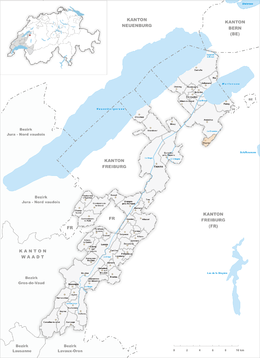Oleyres
| Oleyres | |
|---|---|
| Former municipality of Switzerland | |
| Coordinates: 46°51.22′N 7°2.25′E / 46.85367°N 7.03750°ECoordinates: 46°51.22′N 7°2.25′E / 46.85367°N 7.03750°E | |
| Country | Switzerland |
| Canton | Vaud |
| District | Broye-Vully |
| Area | |
| • Total | 1.92 km2 (0.74 sq mi) |
| Elevation | 551 m (1,808 ft) |
| Population | |
| • Total | 235 |
| • Density | 120/km2 (320/sq mi) |
| Demonym(s) | Les renards |
| Postal code | 1580 |
| SFOS number | 5461 |
| Localities | Oleyres |
| Surrounded by | Avenches, Domdidier (FR), Léchelles (FR), Misery-Courtion (FR) |
| Website |
www Profile (French), SFSO statistics |
Oleyres is a former municipality in the Swiss canton of Vaud in the district of Broye-Vully.
On 1 July 2011 it was merged into the municipality of Avenches.
Oleyres is first mentioned around 1101-50 as de Holeriis. Between 1151 and 1200 it was mentioned as de Oleres.
Oleyres has an area, as of 2009[update], of 1.92 square kilometers (0.74 sq mi). Of this area, 1.34 km2 (0.52 sq mi) or 69.8% is used for agricultural purposes, while 0.42 km2 (0.16 sq mi) or 21.9% is forested. Of the rest of the land, 0.14 km2 (35 acres) or 7.3% is settled (buildings or roads).
Of the built up area, housing and buildings made up 4.7% and transportation infrastructure made up 2.1%. Out of the forested land, 19.8% of the total land area is heavily forested and 2.1% is covered with orchards or small clusters of trees. Of the agricultural land, 44.8% is used for growing crops and 23.4% is pastures, while 1.6% is used for orchards or vine crops.
The municipality was part of the Avenches District until it was dissolved on 31 August 2006, and Oleyres became part of the new district of Broye-Vully.
The municipality is located on a hill that rises above the Broye valley south-east of Avenches. It consists of the linear village of Oleyres.
The blazon of the municipal coat of arms is Per pale Argent and Gules, overall a Crossbow bendwise Or.
Oleyres has a population (as of 2000) of 235. As of 2008[update], 9.1% of the population are resident foreign nationals. Over the last 10 years (1999–2009 ) the population has changed at a rate of -5.6%. It has changed at a rate of -6.9% due to migration and at a rate of 0.9% due to births and deaths.
Most of the population (as of 2000[update]) speaks French (176 or 78.9%), with German being second most common (34 or 15.2%) and English being third (6 or 2.7%).
...
Wikipedia


